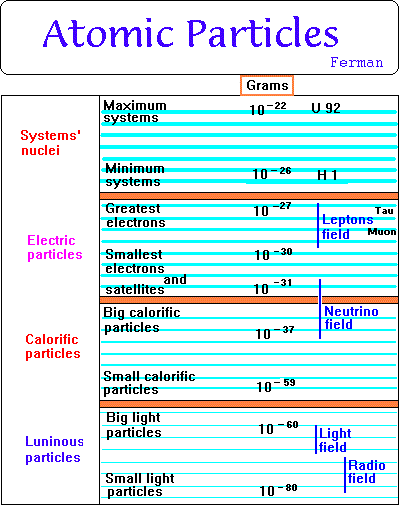Atomic nuclei. Leptons (electrons). Neutrinos. Quarks.
Electric, calorific and luminous particles.

u
a
r
k
s
n the previous charts we can see the wide spectrum of particles that can exist among systems. In this, the main well-known groups are marked, as well as their approximate mass.
At the moment many types of particles continue being discovered, as for example quarks, which are simple pieces of matter coming from the destruction of an atomic nucleus.
The current scientists think that they are approaching to the primary and indivisible particles of matter, although as I explain in this web these looked for particles are Sub-atoms of 10^-79 grams approximately and they are the inferior units to atoms.
The other bigger particles are matter pieces or grouping of these sub-units.
The same that in star, planets etc, where many atoms can form any matter piece, in atoms, electrons, etc, many sub-atoms can form any type of sub-atomic particle.
As we have revised, particles will be many and of very varied magnetic behaviour.
As general norm of magnetic polarity we will say that:
To bigger size of the particle--bigger magnetic potential it has.
Potential that will be considered positive if this particle is lone; against if this particle has associated other satellite particles that give it the convenient magnetic balance, then this particle will be negative o neuter.
Let us remember the Law of Universal Balance:
To so much mass � so much volume occupied by the system.
Or equality of energy density in all places in the space.
If this is completed the group of associate particles will be neuter or negative. If the particle is lone and it is of great size positive magnetic fields or necessity of associate satellites that balance the group will take place.